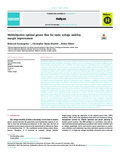| dc.contributor.author | Kyomugisha, R. | |
| dc.contributor.author | Muriithi, Christopher M. | |
| dc.contributor.author | Edimu, M. | |
| dc.date.accessioned | 2022-03-12T08:26:10Z | |
| dc.date.available | 2022-03-12T08:26:10Z | |
| dc.date.issued | 2021-12 | |
| dc.identifier.citation | Heliyon, Volume 7, Issue 12, December 2021, e08631 | en_US |
| dc.identifier.uri | https://www.sciencedirect.com/science/article/pii/S2405844021027341 | |
| dc.identifier.uri | https://papers.ssrn.com/sol3/papers.cfm?abstract_id=3922760 | |
| dc.identifier.uri | https://pubmed.ncbi.nlm.nih.gov/35005280/ | |
| dc.identifier.uri | https://europepmc.org/article/med/35005280 | |
| dc.identifier.uri | https://m.x-mol.com/paper/1471940775611244544 | |
| dc.identifier.uri | http://hdl.handle.net/123456789/5531 | |
| dc.description.abstract | Worldwide, utilities are aiming to increase the stability of modern power systems during system disturbances. Optimizing generation scheduling can improve system security in contingency and stressed conditions while lowering losses and generation costs. An efficient operating strategy for maintaining power system stability is proposed in this work. The paper focuses on incorporating a Voltage Collapse Proximity Index (VCPI) in the traditional optimal power flow problem for multiobjective optimization (MO). Different case studies are assessed to evaluate the impact on the control variables. A Preference Selection index (PSI) is utilized to determine the best-case study for optimal system operation. The effectiveness of the proposed approach is tested on standard IEEE 30-bus and IEEE 57-bus during normal, contingency, and stressed conditions using MATPOWER. During normal conditions, the MO voltage stability constrained optimal power flow (VSC-OPF) increases the system stability by 28.13 % higher than the single objective (SO) case. Furthermore, the transmission losses are lowered by 14.69% with the proposed MO approach. During line outage contingency conditions, the voltage stability enhancement and loss reduction are higher in the MO than in the SO case by 13.60% and 23.19%. However, the loss minimization and stability improvement during normal and contingency conditions come at a slightly higher generation cost of 5.05% in both systems. On the other hand, during stressed conditions, the SO performs better in voltage stability improvement (by 8.77%) and loss reduction (by 6.97%) than in the MO voltage stability constrained OPF. Additionally, PV Curve analysis for the two systems indicates that voltage stability in MO OPF problems provides a more significant margin enhancement of 9.00%, 118.95% in normal and contingency, respectively, higher than the SO case. However, the SO case increases the load margin by 12.36% more than the MO case in stressed conditions. Consequently, the PSI ranks the multiobjective optimization of the three objectives as the most optimal way for operating the systems in normal and line outage contingency conditions. However, during increased load conditions, the system performance is better if a singular objective function is considered. This is due to the lack of adequate reactive power generation during stressed conditions, and hence a singular objective focus is sufficient to assure system stability. Therefore, the proposed approach is an effective preventive control measure for possible voltage collapse in typical power systems. The resulting improvement also brings about a sufficient system stability margin, causing the system to become more secure. | en_US |
| dc.language.iso | en | en_US |
| dc.publisher | Elsevier | en_US |
| dc.subject | Fuzzy decision making | en_US |
| dc.subject | MOPSO | en_US |
| dc.subject | Preference Selection Index | en_US |
| dc.subject | PV curves | en_US |
| dc.subject | VCPI | en_US |
| dc.subject | Voltage collapse | en_US |
| dc.title | Multiobjective optimal power flow for static voltage stability margin improvement | en_US |
| dc.type | Article | en_US |

